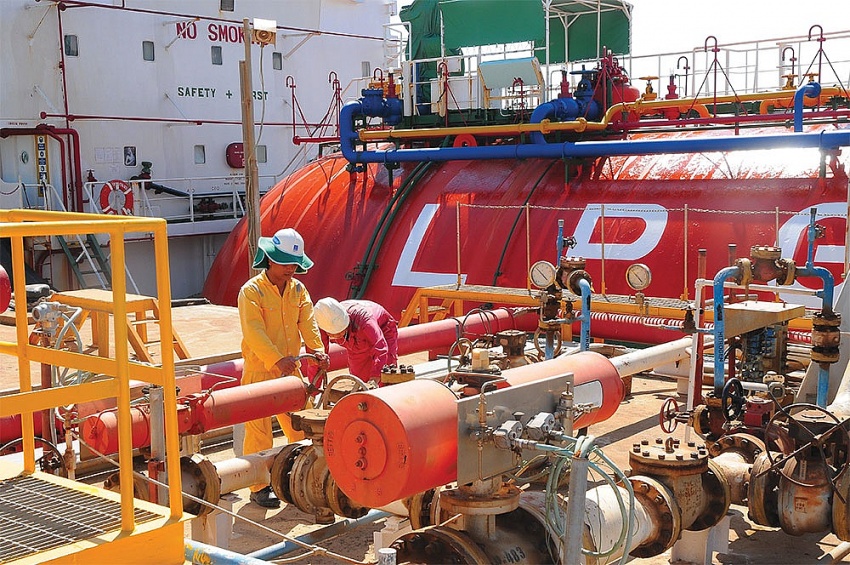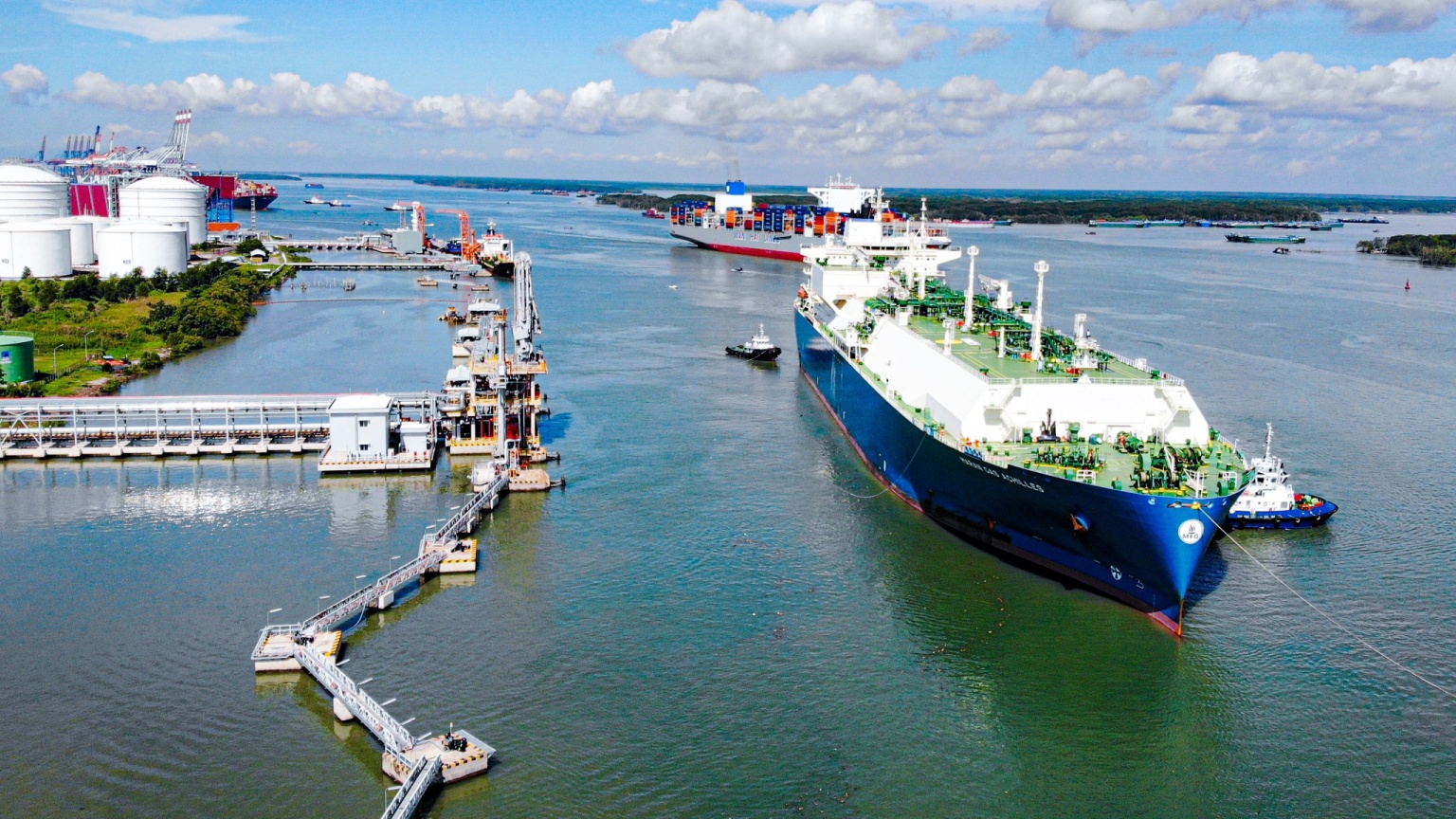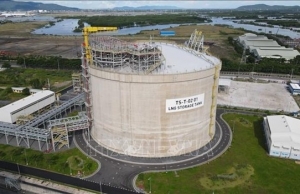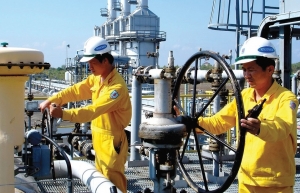Key milestones being hit for LNG prospects
 |
| The LNG market development requires financial support as well as capacity creation, photo Le Toan |
Last week saw the approval of Vietnam’s planning of petrol and gas reserves and supply infrastructure for the rest of this decade, with a vision to 2050.
The overall objective of the master plan is to develop the entire system, including strategic reserves and those for production, commerce, transport, and distribution.
Specifically, of these, for gas storage infrastructure, the planning highlights to ensure storage infrastructure for liquefied petroleum gas at a capacity of up to 800,000 tonnes before 2030 and up to 900,000 tonnes in the period after 2030.
Liquefied natural gas (LNG) storage infrastructure will be ensured enough import capacity to meet the market’s consumption demand. It will contribute to the supply of raw material gas demand for energy and industries, with a storage capacity of up to 20 million tonnes per year before 2030 and up to 40 million tonnes per year afterwards.
To contribute to this target, also last week, Son My LNG Terminal Project Company, a joint venture of AES and PetroVietnam Gas JSC (PV Gas), was granted approval for its $1.3 billion Son My LNG Terminal project by Binh Thuan People’s Committee. The terminal will have an installed capacity of 450 TBtu and is expected to begin commercial operations in 2027.
Joseph Uddo, president of AES Vietnam, said, “The approval for Son My LNG Terminal is a significant milestone that enables us to move forward with the development of this critical infrastructure project. AES is committed to accelerating the future of energy through important projects like this. We are excited to partner with PV Gas on this strategic project that will contribute to Vietnam’s energy transition and economic growth.”
At the end of June, T&T Group and KOGAS, the world’s largest LNG importer and exclusive wholesaler of natural gas in South Korea, signed a deal to jointly develop LNG infrastructure here.
In addition, T&T Energy, a subsidiary of T&T Group, and SK E&S, an energy company under SK Group, also signed an MoU to cooperate in the LNG power sector. They will develop terminals and gas-fired power plants, while SK E&S will take charge of securing the financial resources for implementation.
In Hai Lang district of the central province of Quang Tri, a consortium consisting of T&T Group, KOGAS, Korea Southern Power, and Hanwha Group began the technical phase of a 1,500MW LNG power centre in early 2022. With investment of around $2.3 billion, the project is expected to commence commercial operations in the 2026-2027 period.
LNG is playing a crucial role in ensuring energy supply and facilitating energy transition as laid out in the country’s Power Development Plan VIII, with a goal of 15 per cent of total capacity and 13 gas power plants by 2030. However, Vietnam currently has little existing infrastructure for the energy source. Vietnam’s energy strategy for this decade and beyond highlights development of gas industries, and prioritising infrastructure for import and consumption of LNG. The target is to be able to import about eight billion cu.m of LNG by 2030 and 15 billion cu.m by 2045.
Johan Petter Tutturen, vice president of Det Norske Veritas, a Norwegian classification society and risk management company, said last week that the LNG market development needs financial support and capacity building.
“The scale of LNG projects in Vietnam is small and building relevant storage is too expensive. In addition to the current legal framework, the government should support businesses related to taxation and import equipment for projects,” he said.
In addition to highly appreciating the issuance of the national planning of petroleum and gas reserve and supply infrastructure, Tutturen noted some policies to develop the LNG market such as electricity price, construction and operation permits of an LNG plant, legal framework for infrastructure development, and environmental factors.
“The opening of the electricity price mechanism for LNG power plants will be an important motivation for investors,” he added. “They need some policies related to electricity price agreements between plant developers and power purchaser to ensure stable benefit for both sides.”
 | Thi Vai Terminal receives first LNG shipment As PetroVietnam Gas (PV Gas) works to secure a long-term fuel source for further liquefied natural gas (LNG) gas power facilities, the future stable operation of power facilities in Vietnam is being hampered by a lack of infrastructure to import and store sufficient liquefied natural gas. |
 | 1.3-billion-USD LNG terminal warehouse project gets greenlight The People's Committee of Binh Thuan province has issued a decision approving the investment of Son My liquefied natutal gas (LNG) terminal warehouse project in the south-central province’s Ham Tan district. |
 | Structure lacking for LNG activities The future stable operation of power facilities in Vietnam is being hampered by a lack of infrastructure to import and store sufficient liquefied natural gas. |
What the stars mean:
★ Poor ★ ★ Promising ★★★ Good ★★★★ Very good ★★★★★ Exceptional
Related Contents
Latest News
More News
- CME Solar strengthens position in Vietnamese renewables (December 30, 2025 | 11:21)
- Self-care signals shift towards sustainable healthcare (December 30, 2025 | 10:12)
- GreenYellow marks five years of clean energy growth in Vietnam (December 26, 2025 | 15:51)
- TCP Group partner with VNUS to launch water conservation project (December 25, 2025 | 14:00)
- Heavy industries set for pilot greenhouse gas quotas (December 25, 2025 | 10:00)
- Swedfund invests in MSME growth and climate action in Vietnam (December 19, 2025 | 11:42)
- GreenYellow brings solar energy to light up remote schools in Tuyen Quang province (December 19, 2025 | 08:00)
- Charge+, Grab partner to develop EV charging network in Vietnam (December 18, 2025 | 17:11)
- Linking sci-tech and innovation to Vietnam’s net-zero future (December 18, 2025 | 14:31)
- Driving double-digit growth through green and circular transformation in Vietnam (December 17, 2025 | 09:00)

 Tag:
Tag:















 Mobile Version
Mobile Version